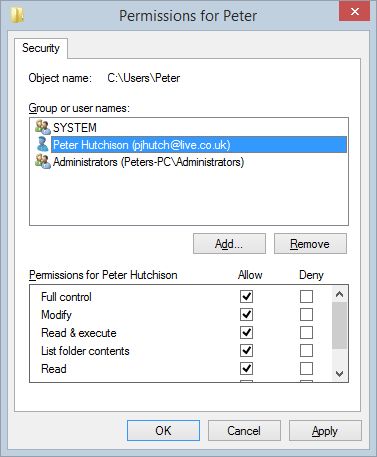
 |
Windows Guide |
Windows is a secure operating system. Which means that you need to logon or authenticate to use Windows applications, services and files. By default Windows comes with two users: 'Administrator' and 'Guest'. You can add more users during the installation of Windows, it will ask for at least one or more users for you or other people to logon. Then each user will have there own desktop and program settings and be able to keep their own documents seperate from any where else.
To create users, use the Accounts under Settings app in the new Start menu. In Email and Accounts and use the 'Add an account', 'Add a Microsoft account' or 'Add a workplace or school account' link. Alternatively, you can use the Local Users and Groups administrative tool.
By default, Windows store user information in the C:\Users\ folder. If you have a look in the folder, they will be folders for Default, Public and possibly some other system folders and folders for all the users you have set up. If a user has not logged yet, then the folder will be created until they have at least logged on once. Typical contents of a folder will have:
AppData - Contains program data files and settings.(Usually
hidden)
AppData\Local - Contains data for local programs, Temp files, and a VirtualStore folder which stores data which may have tried to write to C:\Program files, C:\ProgramData or c:\Windows.
AppData\LocalLow - Contains data for protected mode data e.g. IE, Java, Adobe.
AppData\Roaming - Contains folders for roaming profile which can be stored on a network server. So this means your settings can go with you if you work on different computers.
Contacts - Contains contact files of users. Replaces the Address Book on earlier versions of Windows.
Desktop - Contains all files, shortcuts and so on saved to your Desktop.
Documents - Default documents folder.
Downloads - The default location for downloading of file from a web browser.
Favourites - Contains all your web shortcuts to your favourite web sites.
Links - Contains shortcuts to folders, programs.
Music - The default location for audio, music files including iTunes.
OneDrive -Contains offline copies of files on your cloud OneDrive folder.
Pictures - The default location for picture files such bmp, jpg, gif, png files.
Saved Games - Contains saved game files from Microsoft and other games.
Searches - Contains Indexed locations and save searches.
Tracing - Contains log files
Videos - The default location for video files.
NTUSER.DAT - Contains registry settings specific to that user. See Regedit
under HKEY_Current_User.
NTUSER.DAT.LOG - Contains a log of changes to registry settings (Usually
hidden)
NTUSER.INI - Settings for current user.
Other useful folders.
AppData\Local\Temp - Temporary files folder for user.
AppData\Local\Microsoft\Windows\Burn - Folder used to store
files ready to be burnt to CD with Window's built in CD burner software.
AppData\Roaming\Microsoft\Windows\Recent - Contains shortcuts to recently accessed files.
AppData\Roaming\Microsoft\Windows\Send to - Stores shortcuts to programs that appear in the Send to pop
menu when you right click a file or folder (Usually hidden)
AppData\Roaming\Microsoft\Windows\Start Menu - Stores shortcuts to programs you installed and accessible
for your user only. If you want all users to access the program then move these
folders and shortcuts to All Users\Start Menu folder.
AppData\Roaming\Microsoft\Windows\Templates - Contains template documents used for Office etc
Note if some of these folders or files are missing or corrupt then Windows will not be able to logon correctly and you will not get your usual folders and will instead use a Temporary user profile. Backup your files and delete your user folder or ntuser.dat may correct the problem.
Windows supports NTFS (New Technology File System) as well as FAT32 (File Allocation Table) used in Windows 9x/Me. There are a few advantages with NTFS: You can secure files and folders using special permissions to prevent users making unauthorised changes to the PC, can secure your documents and files from other user, allows use of RAID technology such as Mirroring, Striping, supports larger disks and partitions more efficiently than FAT32, supports compression of files, supports encryption of files.

By default, the Security tab is hidden. This can be enabled by opening explorer, select Tools, Folder Options and click on the View tab. Scroll to the bottom and untick 'Use simple file sharing (Recommended)'. Then you are allowed to see the Security tab.
Full Control - Can read and write all files and folders and can change user permissions.
Modify - Can create, read and write files and folders.
Read & Execute - Can read the contents of files and execute programs.
List Folder Contents - Can view file and folder names only.
Read - Can read contents of files.
Write - Can create and write to files.
Special permissions - Can set additional permissions not listed here (see Advanced).
In Windows, you can make two types of users: Administrator or Standard users. The difference being is that Administrators have full control of the PC, they can install or remove software and drivers, view or change other files, and make changes to permissions and add or remove Users. Standard users have no control over the PC but able to run applications, change their own settings and open or save documents. Usually, the first user you create is a member of the Administrators group.
In the Professional version of Windows, additional local groups are available including Power Users, Backup operators, Guests, Remote Desktop Users, Performance Log users and so on.
See the Local Users and Groups (lusrmgr.msc) or Computer Management tool.
